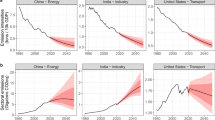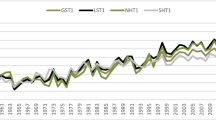Abstract
Probability distributions for carbon burning, atmospheric CO2, and global average temperature are produced by time series calibration of models of utility optimization and carbon and heat balance using log-linear production functions. Population growth is used to calibrate a logistically evolving index of development that influences production efficiency. Energy production efficiency also includes a coefficient that decreases linearly with decreasing carbon intensity of energy production. This carbon intensity is a piecewise linear function of fossil carbon depletion. That function is calibrated against historical data and extrapolated by sampling a set of hypotheses about the impact on the carbon intensity of energy production of depleting fluid fossil fuel resources and increasing cumulative carbon emissions. Atmospheric carbon balance is determined by a first order differential equation with carbon use rates and cumulative carbon use as drivers. Atmospheric CO2 is a driver in a similar heat balance. Periodic corrections are included where required to make residuals between data and model results indistinguishable from independently and identically distributed normal distributions according to statistical tests on finite Fourier power spectrum amplitudes and nearest neighbor correlations. Asymptotic approach to a sustainable non-fossil energy production is followed for a global disaggregation into a tropical/developing and temperate/more-developed region. The increase in the uncertainty of global average temperature increases nearly quadratically with the increase in the temperature from the present through the next two centuries.
Similar content being viewed by others
References
Andronova N, Schlesinger M (2001) Objective estimation of the probability density function for climate sensitivity. J Geophys Res 106:22605–22612
Barro R, Sala-i-Martin X (1995) Economic growth. McGraw-Hill, New York
Bischoff C, Kokklenberg E (1987) Capacity utilization and depreciation rate. Appl Econ 19:995–1006
Box G, Tiao G (1972) Bayesian statistical inference. Addison-Wesley, Reading
Bu Y (2006) Fixed capital stock depreciation in developing countries: some evidence from firm level data. J Dev Stud 45:881–901
Collins M, Booth B, Harris G, Murphy J, Sexton D, Webb M (2006) Towards quantifying uncertainty in transient climate change. Clim Dyn 27:127–147
Darmstadter J (1971) Energy in the world economy: a statistical review of trends in output, trade, and consumption since 1925. Resources for the Future, Washington, DC
Dessai S, Hulme M (2003) Does climate policy need probabilities? Tyndall Centre Working Paper, 34, University of East Anglia, Norwich. http://www.tyndall.ac.uk/publications/working_papers/working_papers.shtml
Dessai S, Hulme M (2004) Climate implications of revised IPCC emissions scenarios, the Kyoto protocoal and quantification of uncertainties. Integr Assess 2:159–170
Dettinger M (2006) A component-resampling approach for estimating probability distributions from small forecast ensembles. Clim Change 76:149–168
Easterly W, Rebelo S (1993) Fiscal policy and economic growth. J Monet Econ 32:417–458
Etemad B, Luciani J (1991) World energy production 1800–1985. Droz, Geneva
Forest C, Stone P, Sokolov A, Allen M, Webster M (2002) Quantifying uncertainties in climate system properties with the use of recent climate observations. Science 295:113–117
Füssel H (2007) Methodological and empirical flaws in the design and application of simple climate-economy models. Clim Change. doi:10.1007/s10584-006-9154-y
Giorgi F (2005) Climate change prediction. Clim Change 73:239–265
Giorgi F, Francisco R (2000) Evaluating uncertainties in the prediction of regional climate change. Geophys Res Lett 27:1295–1298
Goldewijk K (2004) HYDE 2.0, history database of the global environment. National Institute of Public Health and the Environment, Netherlands. http://arch.rivm.nl/env/int/hyde. Accessed 12 June 2005 (subsequently moved to http://www.mnp.nl/hyde)
Gollin D (2002) Getting income shares right. J Polit Econ 110:458–474
Greene AL, Goddard L, Upmanu L (2006) Probabilistic multimodel regional temperature change projections. J Climate 19:4326–4343
Hall R (1988) Intertemporal substitution in consumption. J Polit Econ 96:339–357
Hansen L, Singleton K (1996) Efficient estimation of linear asset pricing models with moving average errors. J Bus Econ Stud 14:53–68
Hansen J, Sato M, Reudy R, Nazarenko L, Lacis A, Lo K, Schmidt G, Russell G, Aleinov I, Bauer M, Bauer S, Bell N, Cairns B, Canuto V, Chandler M, Cheng Y, Cohen A, Del Genio A, Faluvegi G, Fleming E, Friend A, Hall T, Jackman C, Jonas J, Kelley KM, Koch D, Labow G, Lerner J, Menon S, Miller R, Novakov T, Oins V, Perlwitz J, Perlwitz J, Rind D, Romanou A, Shindell D, Stone P, Sun S, Streets D, Tuasnev N, Thresher D, Yao M, Zhang S (2006) Dangerous human-made interference with climate: 2005, a GISS modelE study. Atmos Chem Phys Discuss 6:12549–12610
IPCC (2001) Climate change 2001: mitigation. Intergovernmental panel on climate change third assessment report. Cambridge University Press, Cambridge
Jain A, Yang X (2005) Modeling the effects of two different land cover change data sets on the carbon stocks of plants and soils in concert with CO2 and climate change. Glob Biogeochem Cycles 19. doi:10.1029/2004GB002349
Jones P, Parker D, Osborn T, Briffa K (2001) Global and hemispheric temperature anomalies—land and marine instrumental records. In: Trends: a compendium of data on global change. Oak Ridge National Laboratory Carbon Dioxide Information Analysis Center. http://cdiac.ornl.gov/ftp/trends/temp/jonescru/global.dat. Accessed 14 March 2005
Keeling C, Whorf T (2005) Atmospheric CO2 records from sites in the SIO air sampling network. In: Trends: a compendium of data on global change. Carbon Dioxide Information Analysis Center. Oak Ridge National Laboratory, U.S. Department of Energy, Oak Ridge, Tenn., U.S.A. http://cdiac.esd.ornl.gov/ftp/trends/c02/manualoa.co2. Accessed 21 May 2005 (subsequently moved to http://cdiac.esd.ornl.gov/trends/co2/sio-mlo.htm)
Keller K, Hall M, Kim S, Bradford D, Oppenheimer M (2005) Avoiding dangerous anthropogenic interference with the climate system. Clim Change 73:227–238
Kriegler E (2005) Imprecise probability analysis for integrated assessment of climate change. Ph.D. Thesis, Potsdam University. http://pub.ub.uni-potsdam.de/volltexte/2005/561
Kypreos S (2006) Stabilizing global temperature change below thesholds: Monte-Carlo Analyses with MERGE-ETL. Workshop: cost of inaction. http://www.diw.de/english/dasinstitut/abteilungen/evu/aktuelles/index.jsp. Accessed 10 April 2006
Maddison A (2001) The world economy: a millennial perspective. Organization of Economic Cooperation and Development, Paris
Maddison A (2003) The world economy: historical statistics. Organization of Economic Cooperation and Development, Paris (updates available at http://www.ggdc.net/maddison)
Maier-Reimer E, Hasselmann K (1987) Transport and storage of CO2 in the ocean—an inorganic ocean-circulation carbon cycle model. Clim Dyn 2:6–90
Manne A (2006) MERGE 5.1. Model for evaluating regional and global effects of GHG reduction policies. http://www.stanford.edu/group/MERGE
Manne A, Mendelsohn R, Richels R (1995) MERGE, a model for evaluating regional and global effects of GHG reduction policies. Energy Policy 23:17–34
Mastrandrea M, Schneider S (2004) Probabilistic integrated assessment of “dangerous” climate change. Science 304:571–575
Mitchell B (2003) International historical statistics: Africa, Asia, and Oceania, 1750–2000. Palgrave MacMillan, New York
Murphy J, Sexton D, Barnett D, Jones G, Webb M, Collins M, Stainforth D (2004) Quantification of modelling uncertainties in a large ensemble of climate change simulations. Nature 430:768–772
Myers D, Diener E (1995) Who is happy? Psychol Sci 6:10–19
Nakicenovic N, Alcamo J, Davis G, de Vries B, Fenhann J, Gaffin S, Gregory K, Grübler A, Jung T, Kram T, Lebre La Rovere E, Michaelis L, Mori S, Morita T, Pepper W, Pitcher H, Price L, Riahi K, Roehrl A, Rogner H, Sankovski A, Schlesinger M, Shukla P, Smith S, Swart R, van Rooijen S, Victor N, Zhou D (2000) IPCC special report on emissions scenarios. http://www.grida.no/climate/ipcc/emission/index.htm. Accessed 12 Jan 2007
Nehru V, Dhareshwar A (1993) A new database on physical capital stock: sources, methodology, and results. Rev Anal Econ 8:37–59
Nordhaus W (1992) An optimal transition path for controlling greenhouse gases. Science 258:1315–1319
Nordhaus W (1993) Rolling the DICE: an optimal transition path for controlling greenhouse gases. Resour Energy Econ 15:27–50
Nordhaus W (1994) Managing the global commons: the economics of climate change. MIT, Cambridge
Nordhaus W, Boyer J (2000) Warming the world: economic models of global warming. MIT, Cambridge
Ogaki M, Reinhart C (1998) Measuring intertemporal subsitution: the role of durable goods. J Polit Econ 106:1078–1098
Petschel-Held G, Schellnhuber H-J, Bruckner T, Toth F, Hasselmann K (1999) Tolerable windows approach: theoretical and methodological foundations. Clim Change 41:303–331
Press W, Teukolsky S, Vetterling W, Flannery B (1986) Numerical recipes in FORTRAN. Cambridge University Press, Cambridge. http://library.lanl.gov/numerical/bookfpdf.html
Raisanen J, Ruokolainen L (2006) Probabilistic forecasts of near-term climate change based on a resampling ensemble technique. Tellus Ser A Dyn Meteorol Oceanogr 58:461–472
Ramsey F (1928) A mathematical theory of saving. Econ J 38:543–559
Rao PK (2000) The economics of global climate change. M. E. Sharpe, London
Rethinaraj T (2005) Modeling global and regional energy futures. Ph.D. Thesis, University of Illinois at Urbana-Champaign. Text available as an Arms Control, Disarmament, and International Security Program research report. http://www.acdis.uiuc.edu
Richels R, Manne A, Wigley T (2004) Moving beyond concentrations: the challenge of limiting temperature change. AEI-Brookings Joint Center for Regulatory Studies, Working Paper 04–11
Sachs J (2005) The end of poverty: economic possibilities for our time. Penguin, New York
Schneider S, Lane J (2005) Integrated assessment modeling of global climate change: much has been learned—still a long and bumpy road ahead. Integr Assess J 5:41–75
Singer C, Rethinaraj TSG, Addy S, Durham D, Isik M, Khanna M, Keuhl B, Luo J, Quimio W, Kothavari R, Ramirez D, Qiang J, Sheffran J, Tiouririne TN, Zhang J (2007) Probabilty distributions for carbon emissions and atmospheric response: methods and results. University of Illinois at Urbana-Champaign Program in Arms Control, Disarmament, and International Security Research Report. http://www.acdis.uiuc.edu
Stainforth D, Aina T, Christensen C, Collins M, Faull N, Frame D, Kettleborough J, Knight S, Martin A, Murphy J, Piani C, Sexton D, Smith LA, Spicer R, Thorpe AJ, Allen M (2005) Uncertainty in predictions of the climate response to rising levels of greenhouse gases. Nature 433:403–406
Tol R (1994) The damage costs of climate change—a note on tangibles and intangibles, applied to DICE. Energy Policy 22:436–438
UNSD (2005) Energy statistics 2005. United Nations Statistics Division, New York
Verbeke T, De Clercq M (2006) The EKC: some really disturbing Monte Carlo evidence. Environ Model Softw 21:1447–1454
WDI (2005) World bank development indicators. http://devdata.worldbank.org/dataonline
Webster M, Babiker M, Mayer M, Reilly J, Harnisch J, Hyman R, Sarofim M, Wang C (2002) Uncertainty in emissions projections for climate models. Atmos Environ 36:3659–3670
Wei W (1990) Time series analysis: univariate and multivariate methods. Addison-Wesley, Redwood City
Wolfram S (2003) The mathematica book, 5th edn. Wolfram Media, Champaign
Worrell E, Ramesohl S, Boyd G (2004) Advances in energy forecasting models based on engineering economics. Annu Rev Environ Resour 29:345–381
Zhang J (2000) Energy Economic modeling and optimization. Ph.D. Thesis, University of Illinois at Urbana-Champaign
Author information
Authors and Affiliations
Corresponding author
Electronic Supplementary Material
Below is the link to the electronic supplementary material.
Rights and permissions
About this article
Cite this article
Singer, C.E., Rethinaraj, T.S.G., Addy, S. et al. Probability distributions for carbon emissions and atmospheric response. Climatic Change 88, 309–342 (2008). https://doi.org/10.1007/s10584-008-9410-4
Received:
Accepted:
Published:
Issue Date:
DOI: https://doi.org/10.1007/s10584-008-9410-4




